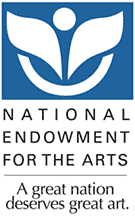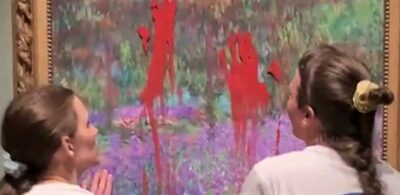Remember the “Obama Arts Policy”?
Recalling the days running up to the 2008 presidential elections, many in the U.S. arts community were giddy with expectation that an Obama Whitehouse would bring about expanded funding and enlightened policies regarding art and culture in the U.S. The fact that the Obama campaign even had an arts policy (.pdf) caused many arts professionals to swoon. Once candidate Obama became President Obama, it was greatly anticipated that he would create a White House Office of the Arts and substantially increase funding for the National Endowment for the Arts (NEA) and the National Endowment for the Humanities (NEH). But now that President Obama has sailed past four months in office, what has he actually accomplished vis-à-vis the arts?
 On May 7, 2009, President Obama’s proposed budget for 2010 was made public, and it contains only slight increases in monies allocated for the nation’s arts and humanities. Appropriations for the NEA have been enlarged by only 3.9 percent, taking the institution’s annual budget from its current $155 million to Obama’s $161.3 million – which is around $15 million less than the NEA’s peak budget of $176 million in 1992 under the Republican presidency of George H.W. Bush. Moreover, Obama’s $6 million increase in NEA funding is still far below the NEA budget hikes of $10.5 million and $20 million made by Republican President George W. Bush during his tenure. The Obama administration has also increased annual funding for the National Endowment for the Humanities (NEH), from its current budget of $155 million to around $171 million. These are completely inadequate budgets for institutions meant to serve the artistic and cultural needs of an entire nation the size of the United States.
On May 7, 2009, President Obama’s proposed budget for 2010 was made public, and it contains only slight increases in monies allocated for the nation’s arts and humanities. Appropriations for the NEA have been enlarged by only 3.9 percent, taking the institution’s annual budget from its current $155 million to Obama’s $161.3 million – which is around $15 million less than the NEA’s peak budget of $176 million in 1992 under the Republican presidency of George H.W. Bush. Moreover, Obama’s $6 million increase in NEA funding is still far below the NEA budget hikes of $10.5 million and $20 million made by Republican President George W. Bush during his tenure. The Obama administration has also increased annual funding for the National Endowment for the Humanities (NEH), from its current budget of $155 million to around $171 million. These are completely inadequate budgets for institutions meant to serve the artistic and cultural needs of an entire nation the size of the United States.
Perhaps the following can place Obama’s proposed funding for the NEA and NEH in context. Obama’s 2010 budget for the federally funded National Science Foundation (NSF) comes to around $7 billion. I have the highest regard for the scientific community, and feel such a budget is completely warranted and advantageous. I wholeheartedly believe the arts and sciences are associated in their pursuit of truth, and it has always been said that the arts and sciences represent the pinnacle of any civilization. Why is it then not conceivable that the National Endowment for the Arts have a budget comparable to that of the National Science Foundation?
President Obama has allocated monies to support the arts across America, but his allotment is simply not enough to even maintain regular operations for a small handful of U.S. art museums. The American arts community is in dire need of work and financial assistance, from legions of artists who live a hand to mouth existence, to long established but currently cash-starved institutions. It goes without saying that due to an imploding economy, a growing number of art galleries, museums, theaters, and concert halls have been forced to curtail programs, slash budgets, fire staff, or close altogether, placing untold numbers of arts professionals in financial jeopardy.
For instance, the 2010 budget for the Getty Museum in Los Angeles, California has been reduced by 22.5 percent, or $64 million. The museum is laying off 205 employees, imposing a hiring freeze, eliminating salary increases for staff, and applying a 6 percent pay cut for senior leadership – and the Getty is America’s most prosperous arts institution! The cut backs and slashing of jobs at the Getty is not an aberration, but a course of action now occurring at cultural venues and institutions all across the country – debilitating and imperiling the cultural life of the nation.
After passing his first 100 days in office, President Obama finally appointed a chairman for the National Endowment for the Arts. On May 13, 2009, the White House tapped celebrated Broadway theatrical producer and businessman Rocco Landesman as head of the NEA. In 1987 Landesman became the president of Jujamcyn Theaters, which owns and operates five theaters on Broadway, and in 2005 he purchased the company outright. As a successful entrepreneur, the well-regarded Landesman has brought a number of big hits to Broadway, including Jersey Boys and Angels in America, but he is not without his controversies.
In 2001 Landesman initiated a hike in theater admission prices, charging $480 per ticket for Broadway performances of The Producers, which he was behind at the time. Even one of the musical’s stars, Nathan Lane, during an appearance on MSNBC’s Today show, referred to the outrageous ticket prices as a “new kind of greediness.” Landesman justified the exorbitant price increase as an attempt at hindering scalpers, but no doubt the move did much to prohibit all but the wealthiest patrons from attending theatrical performances. We will have to wait and see whether or not Landesman will display the same type of elitism as head of the NEA.
President Obama has given powerful executive positions in his  administration to a number of Republicans, and so it should come as no surprise that he would select a former Republican congressman to head The National Endowment for the Humanities. On June 3, 2009, the White House announced that former Republican congressman from Iowa, Jim Leach, would be the next chairman of the NEH. In the words of the president, “I am confident that with Jim as its head, the National Endowment for the Humanities will continue on its vital mission of supporting the humanities and giving the American public access to the rich resources of our culture.”
administration to a number of Republicans, and so it should come as no surprise that he would select a former Republican congressman to head The National Endowment for the Humanities. On June 3, 2009, the White House announced that former Republican congressman from Iowa, Jim Leach, would be the next chairman of the NEH. In the words of the president, “I am confident that with Jim as its head, the National Endowment for the Humanities will continue on its vital mission of supporting the humanities and giving the American public access to the rich resources of our culture.”
Mr. Leach, a so-called “moderate” Republican, also belongs to the powerful Council on Foreign Relations (CFR), an elite bipartisan institution founded in 1921 that in its own words, maintains a commitment “to be the first-stop, nonpartisan resource on U.S. foreign policy and America’s role in the world.” The history of the CFR has shown it to be more than just a “resource,” it has been instrumental in actually shaping U.S. foreign policy. Some of its notable members have included Zbigniew Brzezinski, George H.W. Bush, Dick Cheney, Warren Christopher, Dianne Feinstein, Alan Greenspan, Jeane Kirkpatrick, John McCain, and a host of other big wheels. Corporate members of the CFR include ABC News, Boeing, BP, Citigroup, ExxonMobil, General Electric, Halliburton, IBM, MasterCard, Shell Oil, Verizon, and many other corporate giants.
That being said, my reservations concerning the new heads of the NEA and the NEH are sidebar issues when compared to the core of my complaint: the inadequate budgets Obama has saddled these agencies with. Contrast President Obama’s proposed NEA budget of $161.3 million to his request for “emergency” war-funding for military operations in Iraq, Afghanistan, and Pakistan through this coming September, an amount now set at $105.9 billion. The U.S. House and Senate will no doubt approve the war-funding in an upcoming vote this week. President Obama’s emergency war-funding is separate from his proposed 2010 Pentagon budget of $534 billion; the largest military budget in history, exceeding George W. Bush’s highest military budget proposal by tens of billions of dollars. Even if President Obama managed to somehow boost the NEA budget to $600 million, or even $1 billion – this would still pale in comparison to the monies he is allocating to escalate the wars in Afghanistan and Pakistan.
I would add that the Obama administration has asked Congress for $736 million to build a new “super-embassy” in Islamabad, Pakistan. The building project will outdo the U.S. embassy compound in Iraq’s so-called green zone built under President Bush – which up to this point has been the largest U.S. embassy in the world. President Obama is also seeking additional monies for the expansion of U.S. diplomatic facilities in the Pakistani cities of Lahore and Peshawar, as well as in Kabul, Afghanistan. All together, the building and renovation of these compounds will total $1 billion, far exceeding the cost of the massive embassy built in Baghdad by Bush. Taken in this context, Obama’s arts budget is minuscule indeed.
A visit to the official White House website might give an indication of the importance the arts really have for the Obama administration. Listed on the homepage under “Agenda”, the website presents a roll call of 24 issues of the essence to the President. While important concerns from civil rights to veterans’ affairs appear in the directory, there is no listing for arts policy at all, to find that one must click on the topic of “Additional Issues.” Most agenda items on the White House website are backed by lengthy position papers; the statement on “Homeland Security” comes to 2047 words and the treatise on “Defense” comes to 1244 words. The brief tract on “Arts” however is comprised only of the following 56 words:
“Our nation’s creativity has filled the world’s libraries, museums, recital halls, movie houses, and marketplaces with works of genius. The arts embody the American spirit of self-definition. As the author of two best-selling books — Dreams from My Father and The Audacity of Hope — President Obama uniquely appreciates the role and value of creative expression.”
This seems a rather trifling statement, certainly not one to be construed as a specific White House plan of action regarding national arts policy. It calls to mind a marketing campaign for a book signing tour more than it does the setting down of principles and objectives for a serious governmental approach to arts and culture. It is fine that President Obama and the First Lady have taken to hosting a series of stylish concerts and poetry readings in the East Room of the White House, or that, as The Wall Street Journal reports, “they put the call out to museums, galleries and private collectors that they’d like to borrow modern art by African-American, Asian, Hispanic and female artists for the White House.” These pace-setting events are not insignificant, and while they could be seen as first steps, they should by no means be understood as alternatives to well-funded government arts policy.
Noting the East Room performances and the intention to bring modern art into the White House, the Wall Street Journal wrote that these “choices also, inevitably, have political implications, and could serve as a savvy tool to drive the ongoing message of a more inclusive administration.” It is a rare thing indeed for the corporate press to admit that art has “political implications”, the admission pointing to the timeless method of using art and culture as statecraft. But while the First Family gives a face-lift to the White House art collection and stages trendy concerts in the East Room – I am still waiting for a substantive nationwide arts policy to be implemented.




